What is the triangle offense
The triangle offense is a basketball offensive strategy that primarily consists of three players forming a sideline triangle on one side of the court to create scoring opportunities via the use of various actions such as ball movement, basketball cuts, and basketball screens, mainly based on the reactions of the defense.
Also, the triangle offense could be implemented as a continuity pattern for additional scoring possibilities near the basket or near the perimeter areas of the court.
What is a brief history of the triangle offense
Historically, the triangle offense was initially created by Hall of Famer, Coach Sam Berry during his time as the head coach at the University of Southern California. Afterwards, it was further developed by Hall of Famer, Coach Tex Winter, particularly while he was the head coach at Kansas State University.
Additionally, it should be noted that Coach Winter also played for Coach Berry at USC in the past so Coach Winter was able to learn various aspects of the triangle offense directly from the originator.
Related: The Sam Barry Chronicles: Tex Winter and the triangle offense
Several years later, the triangle offense was popularized by the NBA team, the Chicago Bulls, with Hall of Famer Coach Phil Jackson as the head coach and Coach Tex Winter as one of his assistants.
The Chicago Bulls utilized the triangle offense and its principles to win three straight championships in the seasons of 1990-91, 1991-92, and 1992-93 headlined by Hall of Famers Michael Jordan and Scottie Pippen as well as three more consecutive championships in the seasons of 1995-96, 1996-97, and 1997-98.
Also, during the championship years of 1996 to 1998, the Bulls’ roster included Hall of Famers Dennis Rodman and Toni Kukoč among other players such as Steve Kerr, who hit the game-winning jump shot to give the Bulls their fifth championship in 1997.
Related: Top NBA Finals moments: Steve Kerr’s jumper sinks Jazz in 1997 – NBA.com
Afterwards, Coach Phil Jackson alongside Coach Tex Winter brought the triangle offense to the Los Angeles Lakers NBA team. Similar to the Bulls, the Lakers were able to implement the triangle offense to win three consecutive championships in the years 2000, 2001, and 2002 which featured Hall of Famers Shaquille O’Neal and Kobe Bryant.
Furthermore, Coach Phil Jackson and the Lakers used the triangle offense again to win two more back-to-back championships in the years of 2009 and 2010 which featured six-time NBA All-Star Pau Gasol as well as Kobe Bryant among others. Also, in that 2008-2009 championship season, Coach Tex Winter served as a consultant for the Los Angeles Lakers.
What is the initial setup and player roles of the triangle offense
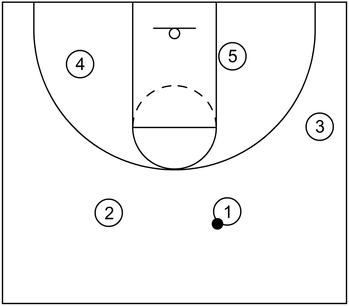
Initial setup
The initial setup for the triangle offense is usually a two guard front near the top, a wing player, a low post player on the same side, and a weak side forward opposite the low post player near the short corner area.
In terms of the player roles and in relation to the traditional basketball positions, generally speaking during the initial setup, player 1 is the point guard, player 2 is the weak side guard, player 3 (i.e. the wing player) is known as the trigger (also referred to as the key), player 4 is the weak side forward, and player 5 is the center.
However, it should be noted that the triangle offense includes innate flexibility and because of that, each player could rotate to any role/position at any given time.
Additionally, during the flow of the offense, each player will have an equal opportunity to touch the basketball and any player could potentially score from the perimeter or near the basket.
For example, player 3 usually begins as the trigger near the wing on the perimeter. However, if player 3 has the ability and skill set to score in the low post, then at some point within offensive execution, player 3 might cut to the low post block, receive the ball from a teammate, and then score with a low post move.
Similarly, player 4 typically starts near the short corner area. However, if player 4 has the ability and skill set to shoot from the mid-range or beyond the three-point arc, then at some particular point throughout the course of offensive action, player 4 could possibly cut towards the perimeter, receive the ball from a teammate, and take the perimeter jump shot if open.
Point guard role
The primary role of the point guard is to pass the ball to the wing and cut to the corner, usually on the same side of the ball. Furthermore, the pass to the wing executed by the point guard is usually referred to as the first pass or the number 1 pass in the triangle offense.
Weak side guard role
The role of the weak side guard is to space the floor, look for potential scoring opportunities when possible, become an alternative passing option if the point guard receives pressure defense beyond the three-point arc, and provide defensive balance in the event of a live-ball turnover.
Trigger role
The role of the trigger (or key) is to pass the ball to one of the other teammates which continues the offensive sequence. Furthermore, the trigger should typically pass to one of the other teammates with a certain priority in mind.
Generally speaking, the trigger should attempt to feed the low post as the first option. If that is not open, then the trigger could pass to the weak side guard (via ball reversal) as the second option.
If that is not open, then the trigger could pass to the weak side forward (who would cut to the strong side high post) as the third option. Finally, if that is also not open, then the trigger could pass to the corner player as the fourth option.
In addition to that, the pass executed by the trigger is known as the second pass or the number 2 pass within the triangle offense.
It should be further noted that this player is referred to as the trigger (or key) because it is this same player that triggers (or initiates) the different scoring options that could be constructed depending on whichever other player received the ball from the trigger. So, it could be said that the trigger probably has one of the most important roles within the triangle offense.
Weak side forward role
The role of the weak side forward is to carry out a certain action, such as set/receive a screen, cut to the high post area, or execute a handoff, usually with the weak side guard via the pinch post.
Center role
The role of the center is to typically shape up via the line of deployment and establish position near the low post block on the same side as the trigger. From that point, the low post player could receive the ball from the trigger and then pass to other teammates or score near the basket themselves.
Also, in some instances, the low post player could set screens for more scoring opportunities.
What is the typical initial action of the triangle offense
Example 1
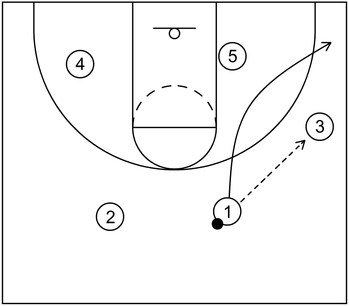
The typical initial action of the triangle offense starts with the point guard (or the player with the ball) at the top executing the first pass (or the number 1 pass) to the trigger. Afterwards, the point guard then cuts through to the same side corner.
Example 2

Alternatively, 1 could execute what is known within the triangle offense as a speed cut for a potential quick scoring opportunity.
In other words, after the trigger receives the ball, 1 could quickly cut straight to the basket. If 1 is not open on the speed cut, then 1 could continue out towards the strong side corner.
What is an example of the sideline triangle alignment

After the trigger receives the ball and the point guard cuts through to the corner, this creates a triangle near the sideline and it is from this sideline triangle to which many of the scoring options occur within the triangle offense.
What is an example of proper spacing within the triangle offense
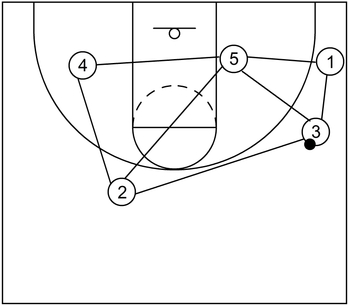
One particular beneficial effect of the sideline triangle is that it automatically features proper spacing. On the diagram above, each of the players are spaced apart about 15 to 20 feet, represented by the various black lines.
However, at lower levels such as youth basketball up to high school, players could have slightly less spacing between 12 to 15 feet.
As long as the players practice good spacing, scoring opportunities should manifest at some point during the offensive sequences. Coincidentally, this type of spacing also showcases two additional triangles besides the primary sideline triangle.
Related: Triangle Basketball Offense For Kids – YouTube
What is the line of deployment within the triangle offense
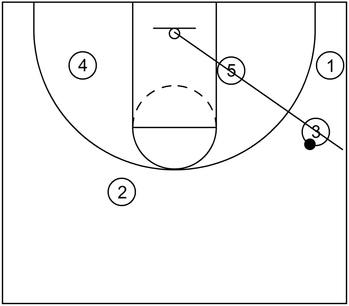
The line of deployment is an imaginary line on the strong side of the ball that runs through the trigger (the player on the wing), the low post player, and the basket. Essentially, when the trigger receives the ball, the low post player should shape up in alignment between the basket and the trigger.
Once that occurs, the trigger should be able to accurately feed the post without much difficulty and the low post player should be able to catch the ball regardless if the low post defender plays low, high, or straight up.
What are examples of low post options within the triangle offense
These are examples of scoring options within the triangle offense that could occur once the trigger passes the ball into the low post.
From that point, the trigger executes a specific action known as a split cut (or split action) by setting a screen away from the ball for a teammate.
Low Post – Example 1 – Part 1
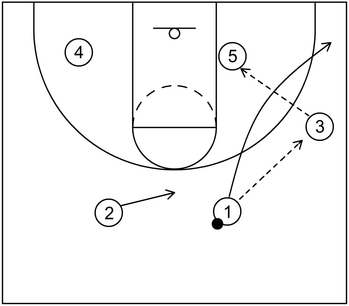
To begin, 3 receives the ball from 1 via the first pass of the triangle offense. Next, 1 cuts through to the strong side corner forming the sideline triangle.
After that, 5 receives the ball from 3 via the second pass of the triangle offense. Also, 2 slides over from the left slot to the middle near the top.
Low Post – Example 1 – Part 2
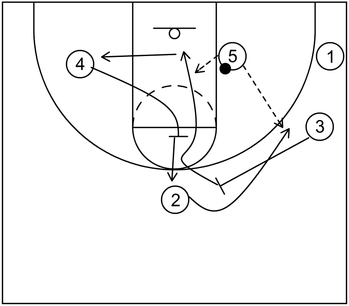
Next, 2 cuts to the right side wing via the away screen set by 3. Following that, screen the screener action occurs in which 3 cuts to the basket by way of the back screen set by 4.
From there, 2 could receive the ball and take the open jump shot or 3 could receive the ball and score near the basket.
Additionally, if those options are not available, then 5 could attempt to score with a low post move while 3 fills and replaces at the the weak side short corner and 4 fills and replaces at the top.
Low Post – Example 2

This is another example in which the point guard cut to the strong side corner to form the sideline triangle and the center has received the ball from the trigger to construct the various potential scoring options.
To begin, 2 cuts to the right side wing via the away screen set by 3. Immediately following that, 4 cuts to the top via a secondary screen set by 3. Afterwards, 2 or 4 could receive the ball for possible three-point jump shot opportunities.
In addition to that, as an alternative scoring option, 3 could slip the second screen towards the basket, receive the ball from 5, and score via a layup/dunk.
Finally, if none of those options are available, then 5 could attempt to score via a low post move.
Low Post – Example 3

This is yet another example in which the point guard cut through to the strong side corner and the center received the ball from the trigger to generate different scoring options. To start, 2 cuts to the right side wing via the away screen set by 3.
At the very same time, 1 cuts to the basket on the low side and could receive the ball from 5 via a handoff to score at the basket.
Next, 2 could receive the ball from 5 and take the open jump shot. However, if 2 is not open, then screen the screener action could occur in which 3 cuts to the basket via the back screen set by 1, receives the ball from 5, and scores via a layup/dunk.
If those options are not there, then 5 could attempt to score via a low post move while 1 cuts to fill and replace at the top and 3 fills and replaces at the right side corner.
Low Post – Example 4 – Part 1

This is an example in which 3 would like to execute a post entry pass. However, 5 did not shape up correctly on the line of deployment (5 is too low and the defender X5 denies on the high side) and therefore, cannot receive the ball.
Low Post – Example 4 – Part 2
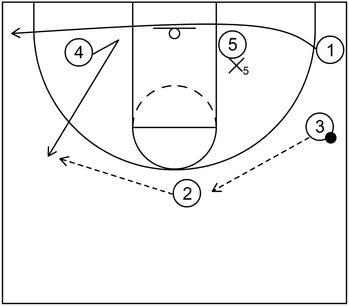
When that occurs, 2 could receive the ball from 3. After that, 4 opens up to the left side wing and receives the ball from 2. Also, at the same time, 1 cuts through to the left side corner.
Low Post – Example 4 – Part 3
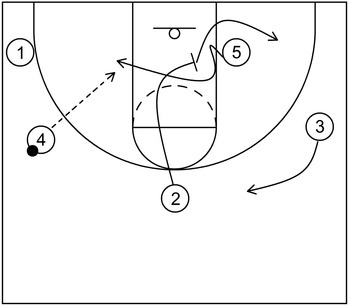
Once 4 receives the ball and 1 cuts to the left side corner, 5 cuts to the left side low post block via the cross screen set by 2. Following that, 2 could flatten out to the weak side short corner or wing area while 3 cuts to the top for defensive balance.
At this point, the sideline triangle occurs on the left side and now 4 is the new trigger. Therefore, 5 could receive the ball from 4 and then the team could execute the various scoring options of the triangle offense.
What are examples of pinch post options within the triangle offense
The pinch post in the triangle offense is typically the weak side high post (or in other words, the high post that is on the opposite side of the center) and it is generally used as two-man action by the weak side forward and weak side guard.
Additionally, to initiate pinch post action, the trigger executes the number 2 pass to the weak side guard at the top and when that occurs, the weak side forward cuts to the weak side high post.
Pinch Post – Example 1 – Part 1
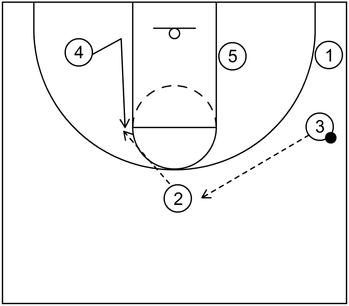
This is an example of pinch post action within the triangle offense. To start, 2 receives the ball at the top from 3. As that occurs, 4 gets open near the left side high post. Following that, 4 receives the ball from 2.
Pinch Post – Example 1 – Part 2

Next, 2 cuts to the basket and could receive the ball from 4 via a handoff. Afterwards, 2 could score near the basket with a layup/dunk. Also, 5 could receive the ball from 2 and score near the rim as well.
Furthermore, as that action occurs, the trigger (in this case, player 3) executes a sequence within the triangle offense known as the rebound screen cut.
It is referred to as the rebound screen cut because 3 will go towards the basket as if to get an offensive rebound.
However, 3 will then quickly set a wide pin down screen for 1 who also cuts to the top. After that, 3 will then cut to the empty right side corner.
Additionally, if 2 is not open on the initial cut to receive the ball from 4, then 1 could receive the ball instead and take the jump shot if open.
Pinch Post – Example 2
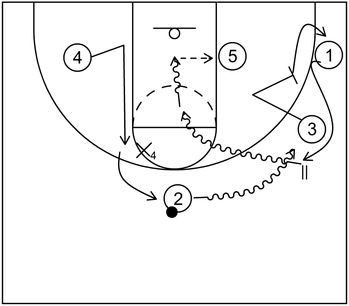
This is an example of a counter within the triangle offense that the offense could execute if the pinch post action gets denied. To start, 2 received the ball from 3 and 4 cuts to the pinch post but X4 takes away that option.
If that occurs, then 2 could begin to dribble towards the right side wing and 1 could cut towards the wing via the rebound screen cut from 3.
Next, 1 could receive the ball from 2 via dribble handoff action and then drive towards the middle of the lane.
From that point, 1 could take the short mid-range jump shot, continue the drive all the way to the basket to score, or 5 could receive the ball from 1 and score near the basket.
Additionally, as that happens, 3 could fill the right side corner while 4 cuts to the top for defensive balance.
What is an example of high post options within the triangle offense
High Post – Part 1

This is an example of high post scoring options within the triangle offense that could be used if the number 2 pass does not go to the low post or top.
To start, 2 cannot receive the ball from 3 because it is being denied by X2. When that occurs, 4 cuts across the lane and flashes to the right side high post.
Next, 4 receives the ball from 3. Immediately following that, 2 backdoor cuts to the basket and this is also known as the backdoor step within the triangle offense.
Afterwards, 2 could receive the ball from 4 via a drop pass and score near the rim. Additionally, 5 could receive the ball from 2 and score near the basket as another scoring opportunity.
Furthermore, if 2 does not receive the ball from 4 during the initial backdoor action, then 2 could fill and replace near the left side short corner or just inside of the wing on the left side.
High Post – Part 2
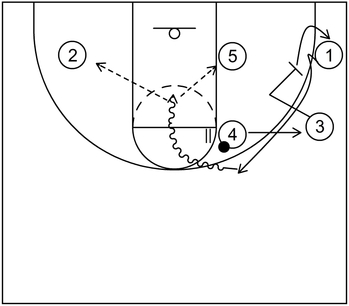
Next, 1 could cut towards 4 to receive the handoff following the rebound screen cut from 3. After 1 receives the ball, 1 could take the short mid-range jump shot in the lane, dribble to score at the basket, or pass the ball to either 2 or 5 for additional scoring opportunities.
What is an example of corner options within the triangle offense
Corner – Part 1
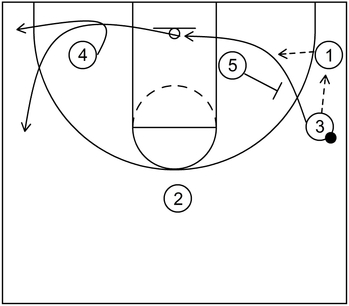
This is an example of corner options within the triangle offense if the number 2 pass does not go to the low post, top, or high post.
To begin, 1 receives the ball in the right side corner. Next, 3 executes a banana cut towards the basket via a back screen set by 5.
If 3 is open, then 3 could receive the ball from 1 and score at the basket. Otherwise, 3 could cut out towards the left side wing and at the same time, 4 could pop to the left side corner.
Corner – Part 2

Following that, 1 could dribble towards the lane via a corner ball screen from 5 who also rolls to the basket. Afterwards, 3 or 4 could receive the ball from 1 and then take jump shots if open.
Additionally, 5 could receive the ball near the basket as well. Furthermore, although it is not shown on the diagram, if 3 or 4 were to receive the ball, then it would be possible to execute a continuity pattern.
To do that, 5 would cut through to the left side low post block to establish the sideline triangle on the left side of the court. From there, if 3 received the ball, then the players could implement either the low post or pinch post options.
Similarly, if 4 received the ball, then the players could implement the corner series once again.
What are examples of solo options within the triangle offense
Solo – Example 1

These are examples of the solo series in which the players form the sideline triangle on the weak side of the court and a two-man game occurs on the strong side.
To begin the action, 3 receives the ball from 1 but this time, 1 speed cuts through to the weak side corner via a rub screen set by 4 who also shapes up near the weak side low post area.
Next, 5 receives the ball and then 3 executes a solo cut towards the basket. Following that, 3 could receive the handoff from 5 and score at the rim with a layup/dunk.
It should also be noted that on the diagram, 3 solo cuts on the low side but 3 could also cut on the high side (as shown by the gray arrow) and if that were the case, then this high side solo cut would also be known as an action zone speed cut within the triangle offense.
Also, when 4 establishes position near the opposite low post block, this is known as the freeze spot within the triangle offense.
It is referred as the freeze spot because, in this case, 4 freezes on the low post block awaiting to receive a screen or a pass from another teammate. Also, in some instances, this spot could be used to get an weak side offensive rebound as well.
Furthermore, 2 executes what is known within the triangle offense as a fan cut towards the garden spot. That is to say, 2 cuts (or fans) away from the ball towards the open area near the weak side wing (i.e. the garden spot) to give more space for the strong side two-man game.
Also, at the same time, 2 should be ready to spot up and shoot the three-pointer if X2 attempts to help, particularly near the strong side low post action.
Furthermore, if 2 receives the ball but does not have the shot, then 2 could initiate the strong side triangle again as the new trigger and 4 as the new low post player.
Solo – Example 2
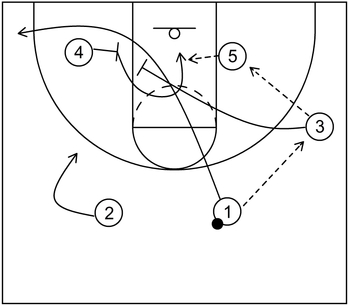
This is another example of the solo option within the triangle offense. The action begins similar as before. 3 receives the ball from 1 who then solo cuts to the left side corner with a rub screen from 4.
However, this time, 4 cuts into the lane from the freeze spot via a screen set by 3. Afterwards, 4 could receive the ball from 5 and score near the basket while 2 fans away to the garden spot as before.
What are the basic pressure release concepts within the triangle offense
The basic pressure release concepts within the triangle offense are known as the line of truth, the moment of truth, and the lag principle.
These particular concepts should be considered if the defense applies extended pressure above the three-point arc and up to (or beyond) the half court line.
Concept #1: Line of truth
The line of truth is an imaginary line that is three feet in front of the ball handler’s defender before the execution of the number 1 pass within the triangle offense.
From that point, if the ball handler’s defender is three feet from the line of truth, then the moment of truth could be established.
Concept #2: Moment of truth
The moment of truth is the exact moment (or timing) when the ball handler is ready to execute the number 1 pass and at the same time, the trigger is open to receive that pass.
Furthermore, as mentioned before, the ball handler’s defender should be three feet from the line of truth.
If the ball handler’s defender is not three feet from the line of truth and/or the trigger is not open to receive the ball during the moment of truth, then the ball handler should implement the lag principle.
Concept #3: Lag principle
The lag principle is a pressure release concept in the triangle offense that occurs when an offensive player, usually the point guard, executes a guard-to-guard pass during the initial action, primarily due to defensive pressure, particularly above the three-point line near (or beyond) half court and/or the trigger is not ready to receive the ball during the moment of truth.
Additionally, in that same initial action, the guard-to-guard pass is also known as a lag pass and the guard (or the player in the opposite slot) that receives the ball should typically lag behind the line of truth.
In other words, the secondary guard that could receive the ball during the initial phase of the lag principle should almost never be above the line of truth or essentially, above the primary guard who would have initial possession of the ball in the opposite slot.
This is an important concept because the secondary guard is not only a defensive safety but is also the main player to release pressure, especially during the initial action if necessary.
What are the basic pressure release counter options within the triangle offense
The basic pressure release counter options are known as the blind pig action and wing reverse action.
These particular counters could be utilized, especially as automatic triggers, when the defense attempts to disrupt certain initial offensive actions within the triangle offense.
Counter #1: Blind pig
Blind pig is a type of pressure release counter option that occurs when the weak side forward executes a flash cut to the strong side high post and receives a pass from the initial ball handler.
Afterwards, the weak side guard in the slot immediately executes a backdoor cut to the basket and could receive the ball from the high post forward if that is open for scoring opportunities at the rim.
Blind pig is typically executed as an automatic sequence during the initial phase of the triangle offense.
The weak side forward should read the defense and execute this automatic if the player in possession of the ball receives extended pressure near the top plus the trigger (during the moment of truth) as well as the weak side guard (via the lag principle) cannot receive the ball to release the pressure. If that occurs, then the weak side forward could execute the blind pig action.
Counter #2: Wing reverse
Wing reverse is a type of pressure release counter option that occurs when the center lifts up from the low post to the strong side high post and receives the pass from the initial ball handler.
Following that, the trigger could quickly backdoor cut to the basket and then receive the ball from the center if that is open for scoring opportunities near the basket.
Additionally, if the trigger is not open to receive the ball, then the initial ball handler and the weak side guard could execute a sequence known as guard squeeze action within the triangle offense.
To execute the guard squeeze action, the initial ball handler can screen for the weak side guard who then cuts toward the center to receive a handoff and score at the rim.
Furthermore, as alternative scoring options, the weak side guard could also pop towards the strong side wing after receiving the screen and at the same time, the initial ball handler could fan away to the garden spot. Afterwards, the center could pass to either player for scoring opportunities.
The wing reverse action could be implemented within the initial phase of the triangle offense as an automatic or as a set play. However, if it is executed as an automatic, the center should usually only lift to the high post if the weak side forward does not flash cut.
In other words, the general idea is to execute blind pig as an automatic first and if that does not happen, then wing reverse could become the secondary automatic trigger.
What is an example of the line of truth within the triangle offense
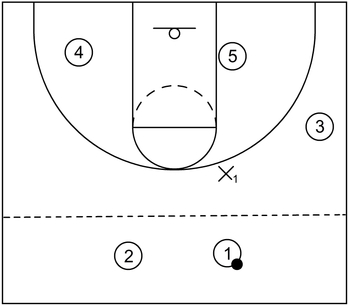
This is an example of the line of truth in which the dotted line on the diagram represents the imaginary line.
It is also being visualized that the line of truth is three feet in front of the ball handler’s defender (for this case, X1). If that is true, then the ball handler (for this case, player 1) is ready to transition into the moment of truth.
What is an example of the moment of truth within the triangle offense
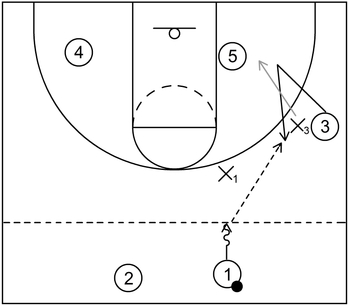
This is an example of the moment of truth within the triangle offense. Notice that as 1 dribbles toward the line of truth, 3 is not initially open. However, 3 executes a V-cut towards the baseline to create separation and X3 chases after (represented by the gray arrow).
Afterwards, 3 gets open near the right side wing as 1 reaches the line of truth. Once that occurs, this is the moment of truth and then 1 executes the first pass (or number 1 pass) to 3.
Following that, 1 could cut to the strong side corner to establish the sideline triangle or 1 could cut to the weak side corner to set up a solo between the trigger and the center.
What are examples of the lag principle within the triangle offense
Lag Principle – Example 1 – Part 1
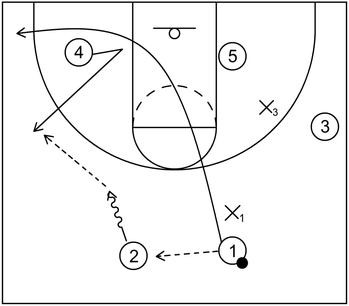
This is an example of the lag principle within the triangle offense. For this example, the trigger is open to receive the number 1 pass but the ball handler receives extended pressure at the top.
This means that the line of truth is not three feet in front of the ball handler’s defender and therefore, the moment of truth cannot be established.
When that occurs, 2 receives the lag pass from 1 and following that, 1 cuts through to the left side corner, which is now the new strong side. Also, at the same time, this lag pass triggers 4 to get open near the left side wing.
At this point, 2 is the new ball handler and 4 is the new trigger. Afterwards, 2 executes the number 1 pass to 4 after taking one or two dribbles to get a better passing angle.
Lag Principle – Example 1 – Part 2A
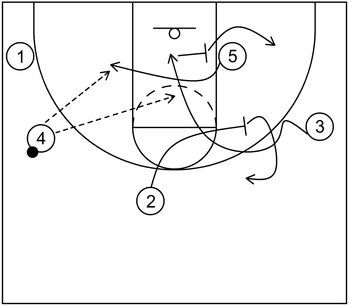
Next, 3 can cut to the basket via a screen set by 2. Following that, 3 could receive the ball from 2 and score near the basket. If 3 is not open, then 5 could cut to the left side low post block via the cross screen set by 3.
At the same time, 3 could cut to the area near the short corner on the weak side while 2 cuts back to the garden spot near the weak side wing.
When this occurs, this establishes a sideline triangle on the left side of the floor. Afterwards, 5 could receive the ball from 4 and execute the various scoring options via split action or by way of a low post move.
Lag Principle – Example 1 – Part 2B
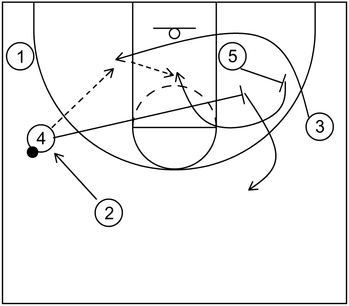
This is an alternative example that could occur after 4 receives the ball from 2. This time, a concept within the triangle offense known as center opposite occurs in which the weak side center stays opposite the ball and the weak side wing cuts through to the strong side low post area.
To implement this concept, 3 cuts to the left side low post block via a back screen set by 5.
Next, 3 receives the ball from 4 and following that, screen the screener action occurs in which 5 curls to the basket via the screen set by 4.
From that point, 5 could receive the ball from 3 and score at the basket or 3 could score via a low post move. Also, as that happens, 2 fills up to the vacated left side wing while 4 cuts back out to the garden spot.
Lag Principle – Example 2 – Part 1

This is another example of the lag principle which will eventually set up a solo after the initial ball handler executes the lag pass.
To begin, 2 receives the lag pass from 1 who then cuts through to the right side corner. Following that, 4 receives the ball from 2 near the wing after creating separation to get open.
Lag Principle – Example 2 – Part 2
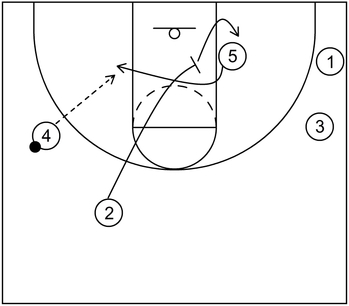
Next, 5 cuts to the left side low post block via the cross screen set by 2. Furthermore, 2 fills the right side low post block which is the new freeze spot after setting the cross screen.
At this point, a triangle gets established on the weak side and there is also a two-man solo on the strong side. Once that occurs, 5 could receive the ball from 4.
Lag Principle – Example 2 – Part 3
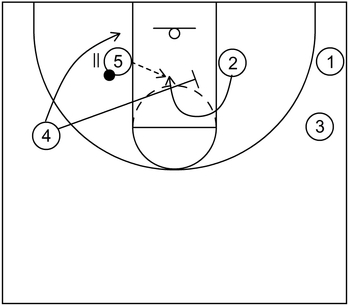
Continuing on, 4 cuts baseline towards the basket and could receive the ball from 5 via a handoff or drop pass.
Also, as an alternative scoring option, 2 could curl cut to the basket via the screen set by 4. Afterwards, 2 could receive the ball from 5 and score near the rim.
Lag Principle – Example 3
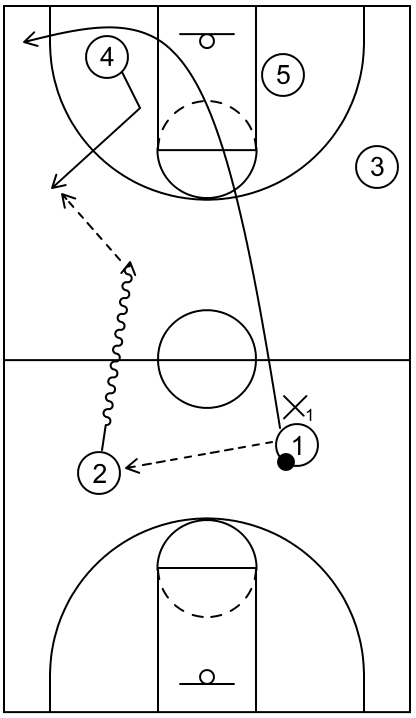
This is an example of the lag principle when the defense applies pressure on the ball handler, particularly in the backcourt. When that occurs, 2 receives the lag pass from 1 and immediately following that, 1 cuts through to the left side corner.
At the same time, 2 dribbles into the frontcourt and as that occurs, 4 receives the ball from 2 after creating separation to get open.
Next, the players could create a new sideline triangle if 5 cuts across to the strong side low post or if 3 cuts to the strong side low post via the center opposite concept as mentioned previously.
What is an example of blind pig within the triangle offense
Blind Pig – Part 1
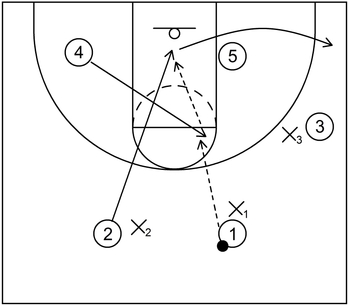
This is an example of blind pig within the triangle offense. This particular scenario is an automatic pressure release by the weak side forward because the initial ball handler receives defensive pressure at the top plus the trigger and weak side guard are denied the wing entry and guard-to-guard pass respectively.
To begin, 4 flash cuts to the strong side high post and then receives the ball from 1. Next, 2 executes the backdoor step with a speed cut, receives the ball from 4, and scores at the basket.
However, if 2 is not open to receive the ball, then 2 could cut to the right side corner to form the sideline triangle on one side of the court.
After that, the players can transition back into the different triangle options, particularly from the high post, as shown on the following diagram.
Blind Pig – Part 2

Next, 1 could speed cut to the basket and receive the handoff from 4 if that is open. If not, then 1 could cut to the weak side short corner or freeze spot.
Afterwards, 2 could cut towards 4 via the rebound screen cut action of 3 and then receive the handoff from 4. From there, 2 could take the mid-range jump shot, drive to the basket, or pass to one of the other teammates for other potential scoring options out of the triangle offense.
What is an example of wing reverse within the triangle offense
Wing Reverse – Part 1
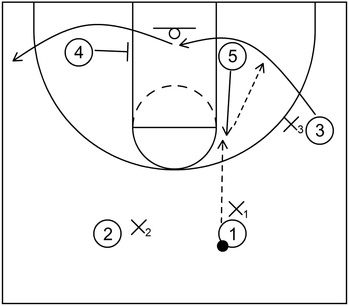
This is an example of wing reverse within the triangle offense. For this scenario, the center releases pressure on the initial ball handler because of the extended on-ball defense by X1 plus denial defense at the opposite slot and strong side wing by X2 and X3 respectively.
To begin, 5 lifts to the strong side high post and then receives the ball from 1 to release the pressure. Next, 3 cuts to the basket via the backdoor step, receives the ball from 5, and scores near the rim.
Also, if 3 is not open to receive the ball, then 3 could continue the cut towards the left side corner by way of the brush screen set by 4 who also gets positioned near the freeze spot.
Wing Reverse – Part 2
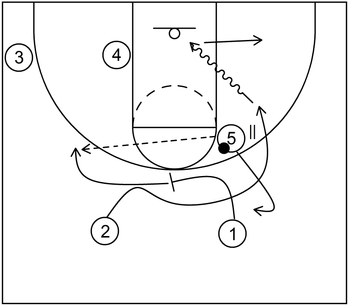
The next phase is an implementation of the guard squeeze action. 2 cuts towards 5 via the top screen set by 1. Following that, 2 could receive the handoff from 5, dribble to the basket, and score at the rim.
However, if 2 does not receive the ball, then 2 could cut out towards the right side short corner area. Furthermore, after setting the screen, 1 could fan away to the garden spot, receive the skip pass from 5, and then take the three-point shot if open.
In addition to that, it should be noted that if 1 receives the ball but does not take the shot, then 5 could pop out to the top as a defensive safety.
At that point, the players could execute the different scoring options as there is a sideline triangle formed on the left side of the court.
What are examples of pick and roll options within the triangle offense
For the triangle offense, the typical pick and roll action occurs within the corner series. However, it is still possible to execute alternative ball screen options for additional scoring opportunities.
Pick and Roll – Example 1
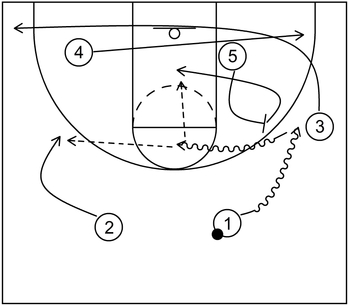
This is an example of a sideline pick and roll quick hitter within the triangle offense. To start, 1 dribbles toward the right side wing and when that occurs, 3 cuts through to the left side corner. Also, 4 cuts across to the right side corner.
Next, 1 dribbles toward the middle of the lane via the on-ball screen set by 5. Following that, 5 could roll to the basket, receive the ball from 1, and then score near the rim.
Also, as an alternative scoring option, 2 could execute a fan cut to the garden spot near the left side wing, receive the ball from 1, and take the jump shot if open.
Furthermore, it is not shown on the diagram but if 2 is not open to take the jump shot, then 5 could cut to the left side low post block, 4 could cut back in near the right side short corner area, and 1 could cut to the top as a defensive safety.
From that point, a sideline triangle would be formed on the left side of the court and the players could execute the various options of the triangle offense.
Pick and Roll – Example 2 – Part 1
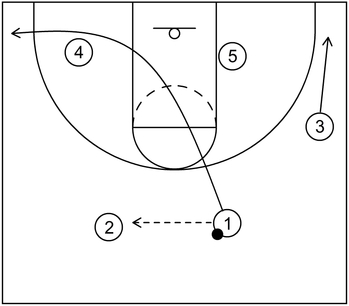
This is an example of Spain pick and roll action within the triangle offense. To start, 2 receives the lag pass from 1. Afterwards, 1 cuts through to the left side corner and at the same time, 3 cuts down to the right side corner.
Pick and Roll – Example 2 – Part 2
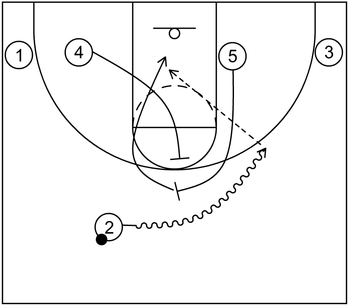
Next, 2 dribbles toward the right side of the court via the on-ball screen set by 5. Following that, 5 rolls to the basket by way of a Spain screen set by 4. Afterwards, 5 could receive the ball from 2 and score near the basket.
Furthermore, it is not shown on the diagram but if 5 is not open to receive the ball near the basket, 5 could cut to the right side low post block. Also, as that occurs, 1 could cut in to the short corner area on the left side.
Additionally, 4 could cut to the top as a defensive safety. From that point, a sideline triangle would be established on the right side of the court and therefore, the players could execute the different options within the triangle offense.
Pick and Roll – Example 3 – Part 1

This is an example of a unique option known as a guard quickie within the triangle offense. To execute the guard quickie action, the center will set a UCLA screen near the high post and then follow that up with an on-ball screen near the sideline.
To begin this particular sequence, 3 receives the ball from 1 and following that, 1 speed cuts to the basket via the UCLA screen set by 5. At the same time, 4 cuts across to the right side corner.
From that point, 1 could receive the ball from 3 and score near the rim if that is open. On the other hand, if 1 does not receive the ball from 3, then 1 could cut out to the left side corner.
Pick and Roll – Example 3 – Part 2
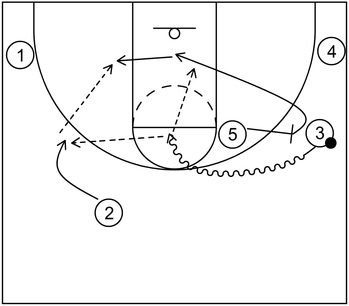
Next, 3 dribbles towards the middle of the court via the on-ball screen set by 5. Following that, 5 rolls to the basket, receives the ball from 3, and then scores at the rim. Also, 3 could take the mid-range jump shot if that is open.
Additionally, as the ball screen action happens, 2 fans away to the garden spot and could receive the ball from 3 as well. If that occurs, then 2 could take the three point shot if open.
Conversely, if 2 receives the ball but does not take the shot, then 5 could continue the cut towards the left side low post block.
Also, even though it is not shown on the diagram, 4 could cut in towards the right side short corner and 3 could cut back to the top as a defensive safety.
From that point, a sideline triangle gets established on the left side of the court and then, the players could execute different options within the triangle offense.